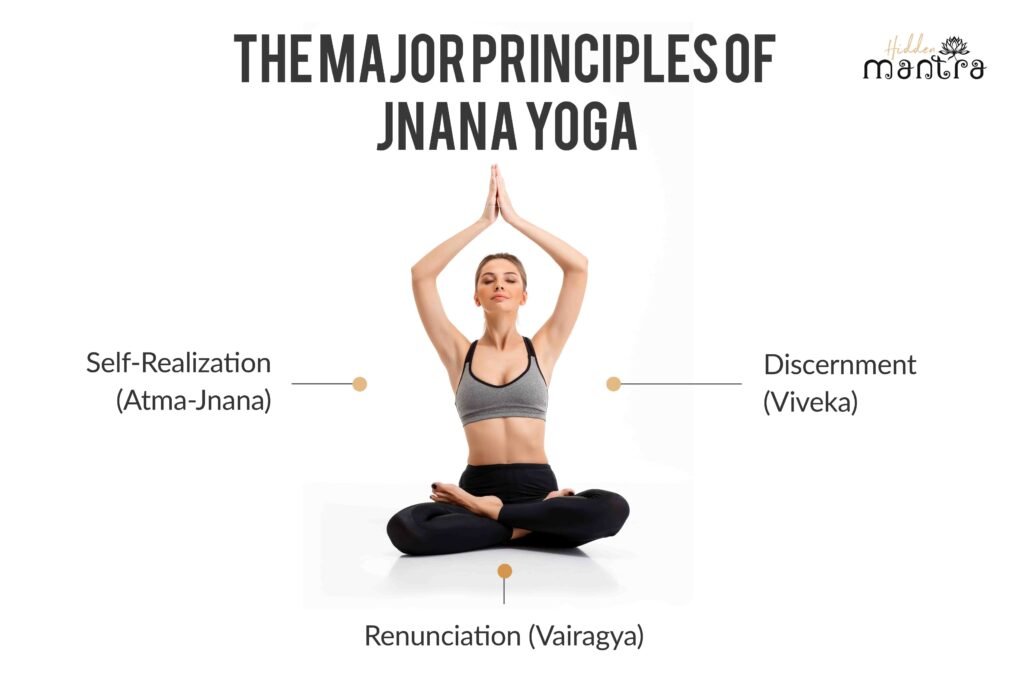Table of Contents
ToggleJnana Yoga is known as the path of wisdom or the path of knowledge. The root word of the term Jnana is originally derived from the Sanskrit word knowledge. It is the combination of both Brahman (ultimate reality) and Atman (inner Self).
Practising Jnana Yoga is a useful method of attaining knowledge. It can be only done through methods such as self-study, meditation and contemplation practices. Jnana Yoga is one of the important streams of Yoga. It comes along with Bhakti (devotion), Raja (meditation), and Karma (action).
Initially, we saw that Jnana yoga is the path of wisdom and as one of the three fundamental paths in Hinduism Jnana yoga plays a role in attaining Moksha or liberation. Liberation is only achieved through the knowledge of Brahman we learned through Jnana Yoga. In this blog, we are going to explore the major details of Jnana Yoga. Let’s dive in.
Seeking Wisdom: Core Principles and Practices of Jnana Yoga
Jnana yoga guides people to achieve self-realization in real life. It also aids in attaining liberation from all the sufferings of the world we exist. In simple words, it is a spiritual practice that ultimately leads you to attain universal consciousness and understand divine truth. When we take into account other Yogic practices, Jnana yoga is regarded as one of the most twisted ones. This is mainly due to the amount of work it needed to accomplish it.
Now we are going to explore the major principles of Jnana Yoga in detail to understand better.

1.Self-Realization (Atma-Jnana)
The first core principle of Jnana Yoga is Self-realization otherwise known as Atma-Jnana. The people who practice Jnana Yoga are equipped to understand the real nature of Atman or Self and identify its relation to the ultimate reality or Brahman. This understanding ultimately leads to a stage which is beyond the individuality of a person and their ego.
2.Discernment (Viveka)
Another crucial component of Jnana Yoga is discernment or viveka. By practising Jnana Yoga one will get the ability to identify the difference between the momentary and the eternal also, the real and the unreal. It also helps the practitioners to catch beyond the illusions that exist in the material world.
3.Renunciation (Vairagya)
A Jnana Yogi is practised to deny all the attachments of worldly desires. By practicing renunciation one could unleash all the material possessions and emotional attachments. It helps the individual to get rid of all the obstacles that occupy their mind and have a free mind. Only a mind without the concerns of worldly possessions can concentrate on the quest for higher knowledge and spiritual awakening.
The Tools of Wisdom: Illusion and Reality
Jnana Yoga plays a huge role in breaking out of the world of Maya (illusion). According to Hindu Philosophy, Maya is the concept that everyday reality is an illusion. This is the reason behind restricting our thoughts and perceptions. It has the power to incorporate the Brahman (ultimate reality) and Atman (inner Self).
How a practitioner of Jnana Yoga gets rid of the impact of Maya is through mental practices such as self-questioning, reflection, and meditation. It removes all the illusions and helps to find harmony within everything.
The major aim of Yoga is to achieve wisdom about the actual reality of the Self and be set free from illusion. How a yogi does this by differentiating between Self and not-self and also between real and the unreal.
Jnana Yoga is suitable for people who have an intellectual nature and are keen and intelligent. Learning scriptures and yogic texts is also an integral part of Jnana Yoga.
Another important concept in Jnana Yoga is Viveka. Viveka is one of the four pillars of Jnana Yoga. These pillars aim to develop spiritual understanding and eliminate suffering.
Viveka equips individuals to understand the differences between the real and the unreal. It is not a momentary thing; instead, it is a result of consistent intellectual effort. A person who possesses Viveka is always vigilant and never gets intertwined in anything. Viveka gives individual inner power and mental harmony and it ultimately leads to Vairagya (dispassion).
The Fruits of Wisdom: Liberation and Beyond
The quintessential aim of Jnana yoga is to accomplish Moksha (liberation). We already learned that Jnana Yoga is the path of intellect and it ultimately paves to the fact that the concept of Jiva and Brahma are indivisible. In Hinduism, Jnana guides one to Moksha or liberation.
According to Advaita Vedanta Jnana Yoga assists in attaining Moksha and also emphasizes that bliss is the outcome of knowledge and work. When it comes to Hinduism major aim of life is to accomplish Moksha. Moksha liberates one’s soul from the cycle of life, death, and rebirth. If one wants to attain, one must get rid of all the material pleasures of the world and develop an understanding of the soul and universe.
The most important fact is the only way to attain unity is by understanding oneself and having knowledge. Jnana yoga leads one person to develop knowledge and enlightenment and it is important to achieve self-knowledge. It is a process that includes receiving knowledge, analyzing it, comprehending it and eliminating from ego. By detaching from the ego, one can be closer to purity.
Walking the Path: Who is Jnana Yoga For?
Jnana yoga is not for everyone. It is for people who are seeking introspective reflection. This spiritual practice comprises studying and meditating to obtain knowledge and self-realization. It also helps in building the unity of Atman (individual Self) and Brahman (ultimate Self).
Jnana yoga is mostly preferable for intellectual people. Because it is the path of wisdom, people with a philosophical nature can understand it better. The practitioners of Jnana Yoga, known as Jnana Yogis, could recognize the role of Maya or illusions in the creations. They are in search to find out what is eternal or permanent amidst all the changes.
To practice Jnana Yoga in its ultimate form, one needs the support and guidance of a guru. A guru has personal experience and in-depth knowledge of Jnana Yoga. A Guru can only transmit it to the disciples with clarity. It is sure that there will be doubts on the part of the disciples only a guru can clarify and give insight into his learning. Guru is capable of providing personal guidance and fixing the parts that require attention. To harvest the right fruits of Jnana Yoga, the proper guidance of a Guru is a must one to follow.
In a nutshell, Jnana Yoga has the power to liberate us from the illusions of the materialistic world we exist. Only the right practice of Jnana Yoga with the guidance of a Guru can help you get rid of the ego and improve awareness. Ultimately, you can achieve the major goal of life, enlightenment. An important thing is don’t be hard on yourself by forcing you to do it all together. Give time and transform your life. For more such interesting topics regarding Yoga do visit our website Hidden Mantra. Let’’s start your journey to enlightenment.









